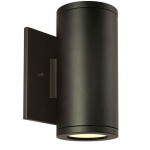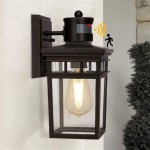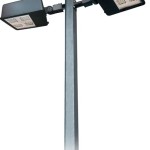Illuminating Your World: The Benefits of LED Lights Outdoors
Outdoor lighting plays a crucial role in enhancing the safety, security, and aesthetics of residential and commercial properties. Selecting the appropriate lighting solution demands careful consideration of factors like energy efficiency, durability, and light quality. Light Emitting Diode (LED) technology has emerged as a dominant force in outdoor lighting, offering a compelling array of advantages over traditional lighting options such as incandescent, halogen, and high-pressure sodium lamps.
The widespread adoption of LED lights for outdoor applications stems from their superior performance characteristics, longer lifespan, and reduced environmental impact. From illuminating pathways and driveways to accentuating architectural features and enhancing security measures, LEDs provide versatile and cost-effective solutions for various outdoor lighting needs. Understanding the specific benefits of LED technology is essential for making informed decisions about outdoor lighting upgrades and installations.
Energy Efficiency and Cost Savings
One of the most significant advantages of LED lights is their exceptional energy efficiency. Compared to traditional incandescent bulbs, LEDs consume significantly less electricity to produce the same amount of light. This reduction in energy consumption translates directly into lower electricity bills, providing substantial cost savings over the lifespan of the lighting system. The energy efficiency of LEDs is measured in lumens per watt (lm/W), indicating the amount of light output produced per unit of energy consumed. LEDs typically boast much higher lm/W values compared to other lighting technologies, making them a more sustainable and cost-effective choice.
For example, a traditional incandescent bulb might produce 10-20 lm/W, while a comparable LED bulb can achieve 80-100 lm/W or even higher. This means that an LED bulb can produce the same amount of light as an incandescent bulb while consuming five to ten times less energy. Over time, these energy savings can accumulate significantly, especially in outdoor lighting applications where lights are often left on for extended periods.
Moreover, the reduced energy consumption of LEDs also contributes to a lower carbon footprint. By using less electricity, LED lighting helps to reduce the demand for power generation, which often relies on fossil fuels. This, in turn, helps to mitigate greenhouse gas emissions and combat climate change, making LEDs an environmentally responsible lighting solution.
In addition to lower electricity bills, the long lifespan of LEDs also contributes to cost savings. Because LEDs last significantly longer than traditional bulbs, they require less frequent replacement, reducing maintenance costs and the labor involved in replacing burned-out bulbs. This is particularly beneficial in outdoor lighting applications where bulbs may be difficult to access or require specialized equipment for replacement.
Durability and Longevity
LED lights are renowned for their exceptional durability and longevity, making them ideal for outdoor environments. Unlike traditional bulbs with fragile filaments or glass enclosures, LEDs are solid-state devices constructed from durable materials. This construction makes them resistant to shock, vibration, and impact, ensuring reliable performance even in harsh weather conditions.
The lifespan of an LED is typically measured in hours, with many high-quality LEDs boasting lifespans of 50,000 hours or more. This means that an LED light can last for several years, even with continuous use, before requiring replacement. In contrast, incandescent bulbs typically have a lifespan of only 1,000 hours, while halogen bulbs last for around 2,000 hours. The longer lifespan of LEDs significantly reduces maintenance costs and the frequency of bulb replacements, making them a more practical and cost-effective choice for outdoor lighting.
Furthermore, LED lights are less susceptible to damage from temperature fluctuations. Unlike some traditional lighting technologies that can be affected by extreme heat or cold, LEDs are designed to operate reliably within a wide temperature range. This makes them suitable for use in various climates and outdoor environments, ensuring consistent performance regardless of the weather conditions.
The robustness of LEDs also extends to their resistance to moisture and humidity. While not all LEDs are waterproof, many are designed with water-resistant or waterproof enclosures, making them suitable for use in damp or wet locations. This is particularly important for outdoor lighting applications where lights may be exposed to rain, snow, or other forms of precipitation.
Enhanced Light Quality and Control
LED lights offer superior light quality and control compared to traditional lighting technologies. LEDs produce a clean, bright light that is free from flickering and buzzing, providing a more comfortable and visually appealing lighting experience. The color rendering index (CRI) of LEDs is typically higher than that of other lighting technologies, meaning that they render colors more accurately and naturally.
The CRI is a measure of how well a light source reproduces the colors of objects compared to a natural light source such as sunlight. A CRI of 100 indicates perfect color rendering, while a CRI below 70 may result in inaccurate or distorted colors. LEDs typically have CRI values of 80 or higher, making them suitable for applications where accurate color rendering is important, such as illuminating gardens, landscapes, or architectural features.
In addition to superior light quality, LEDs offer greater control over light output and direction. They can be easily dimmed to adjust the brightness level, allowing for customized lighting schemes and energy savings. Many LED fixtures also incorporate features such as adjustable beam angles and directional light control, allowing for precise illumination of specific areas or objects.
Furthermore, LEDs are available in a wide range of color temperatures, allowing for further customization of the lighting environment. Color temperature is measured in Kelvin (K) and indicates the warmth or coolness of the light. Lower color temperatures (e.g., 2700K-3000K) produce a warm, yellowish light that is ideal for creating a cozy and inviting atmosphere, while higher color temperatures (e.g., 4000K-5000K) produce a cool, bluish light that is better suited for task lighting or security applications. The versatility in color temperature allows users to tailor the outdoor lighting to their specific needs and preferences.
Smart LED lighting systems also offer advanced control features, such as remote control via smartphone or tablet, scheduling capabilities, and integration with other smart home devices. These systems allow for automated lighting control, energy monitoring, and enhanced security features, providing users with greater control over their outdoor lighting environment.
Beyond the practical aspects, LED lighting also contributes to the aesthetic appeal of outdoor spaces. The ability to precisely control light direction, intensity, and color temperature allows for the creation of stunning visual effects, highlighting architectural features, accentuating landscaping, and enhancing the overall ambiance of the property. The clean, modern look of LED fixtures also complements a wide range of architectural styles, adding a touch of sophistication and elegance to outdoor spaces.
The use of LED lighting for outdoor security is also a notable benefit. Well-lit areas around a property deter potential intruders, and the instant-on capability of LEDs means no delay in illumination when needed. Furthermore, motion-activated LED security lights provide an added layer of protection, illuminating only when motion is detected, conserving energy while enhancing security.
Finally, it is crucial to consider the environmental impact when selecting outdoor lighting. LED lights are mercury-free, unlike some other lighting technologies, making them a safer and more environmentally friendly choice. Their energy efficiency also reduces the carbon footprint associated with electricity generation, contributing to a more sustainable future. By choosing LED lighting for outdoor applications, property owners can reduce their energy consumption, lower their carbon footprint, and create a safer, more beautiful, and more sustainable environment.

Can Led Lights Be Used Outdoors Bpm Electric

Outdoor Led Lighting Ideas For Any Style Backyard

Outdoor Heavy Duty Led String Lights Lighting Legends

Color Changing Waterproof Strip Lights For Outdoor Landscape Lighting

Outdoor Led Lighting Exterior Light Fixtures E Conolight

Led Solar Lawn Lights Decorations Outdoor Waterproof Fairy Flower Starburst Stake With 8 Modes Home Decor Bedroom Wedding Holiday Garden Office

The Advantages Of Outdoor Led Lighting

The Complete Guide To Outdoor Led Strip Lights Lighting Access

Homehop Solar Led Lights For Garden Outdoor Home Wall Step Decorative Waterproof Lamps

App Controlled Led Lights In Us The Only You Will Need
Related Posts







